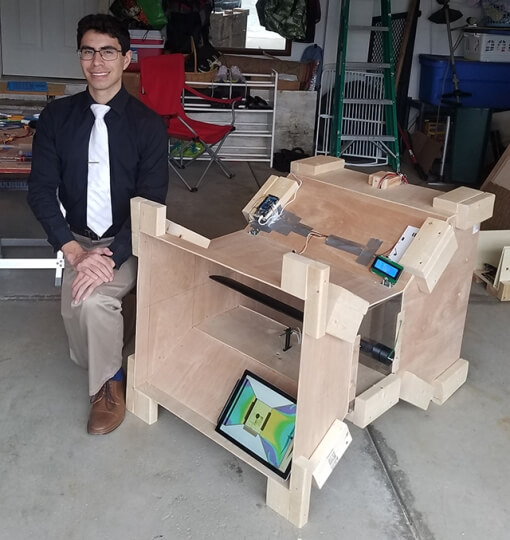Engineering Design Projects (ES 100), the capstone course at the Harvard John A. Paulson School of Engineering and Applied Sciences, challenges seniors to engineer a creative solution to a real-world problem.
Low-cost, Educational Wind Tunnel
John Schmidt, S.B. ’21, mechanical engineering
Please give a brief summary of your project.
My project was on the design of a low-cost, educational wind tunnel. Wind tunnels are devices that simulate airflow around objects such as scaled down cars and airplanes in order to predict how they behave in real conditions, but most high quality tunnels are designed for industry and research, making their cost quite high, sometimes in the range of millions of dollars. On the other hand, low-cost wind tunnels for educational use usually do not have the ability to make accurate and precise quantitative data. As a result, there are many undergraduate institutions that could benefit from using wind tunnels as aids in teaching basic aerodynamic principles, but will not purchase industrial grade wind tunnels just for classroom use. This wind tunnel design addresses that issue by meeting specific size, airspeed, and sensing specifications in order to measure lift and drag forces on test objects such as cylinders and airfoils in low speed flows. The new design allows for placement on demonstration carts so it can be moved throughout classrooms/labs and can measure forces as low as 0.1 grams force in 25 mph winds, while having an overall cost of just over $800, achieving the goal of designing an educational wind tunnel for undergraduate institutions at low cost.
What was the inspiration for this project?
My inspiration for taking on this project came from taking the fluids course “Introduction to Fluid Mechanics and Transport Processes” (ES 123) during my junior year. In that class, I learned about basic aerodynamic principles through lecture and computer simulations. I have heard about wind tunnels only briefly in the past, but I saw an opportunity to potentially help future students by applying the hands-on aspect of wind tunnels to enhance their learning.
What were the biggest challenges of this project?
In my mind, the two biggest challenges of this project were the design of the power plant section of the wind tunnel and the design of the flow straighteners. The power plant is the back section that houses motors and fans that pull air through the whole wind tunnel. In order to keep the overall cost low, I came up with an idea to increase the power plant efficiency and lower the total power requirement, which was verified through testing various motor and fan setups on an 8:25 scale mock power plant. The final power plant design uses two motors with one fan each spinning in the same direction, one motor behind the other.
As for the other challenge, I had to come up with a wind tunnel design that kept the airspeed as uniformly close to 25 mph at full power as possible. Iterating on the overall shape of the wind tunnel was not enough, so devices that direct the airflow in one direction, known as flow straighteners, were added. Different iterations on the type of flow straighteners were simulated in COMSOL to measure flow properties through the wind tunnel until a desired uniformity was reached, and the result was two sets of flow straighteners made of an array of straws 1 inch in length placed at different distances from the wind tunnel’s air inlet.
What did you learn through this experience?
I think the big takeaway that I learned from my project came from the virtual aspect of it. ES 100 students were told from the start to plan as if the whole year was virtual, which turned out to be a valid assumption. Even though I did not have access to the SEAS labs or machine shop, I was still able to fully design the wind tunnel and complete my project. So, I would say that this process has really taught me to be resourceful, and it amazes me that so much can still be accomplished despite being away from campus.
Press Contact
Adam Zewe | 617-496-5878 | azewe@seas.harvard.edu
